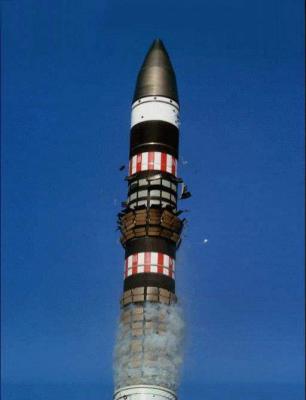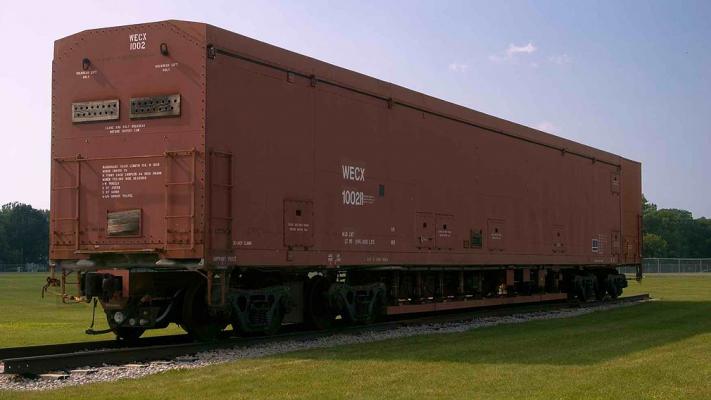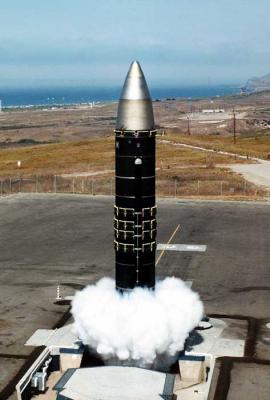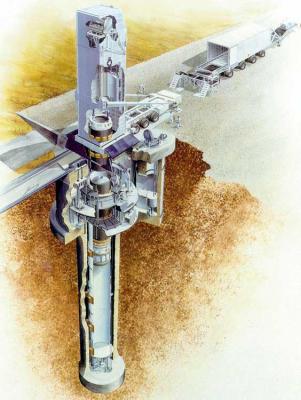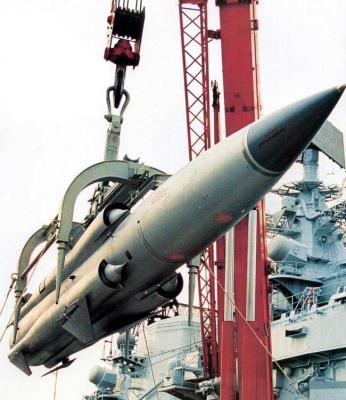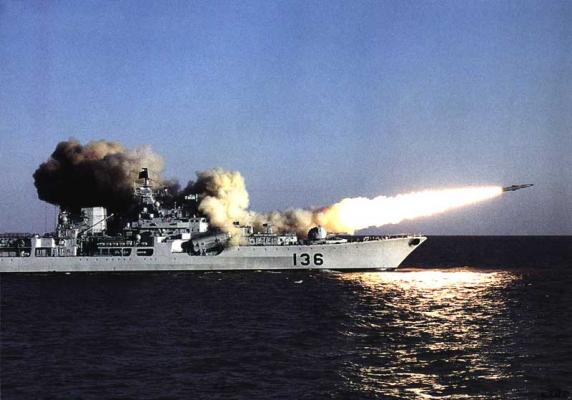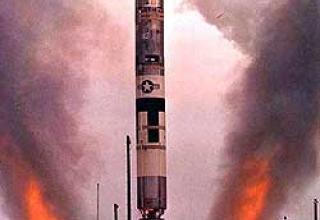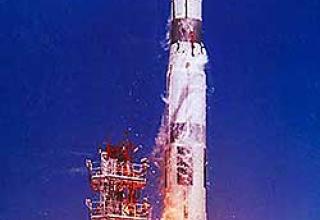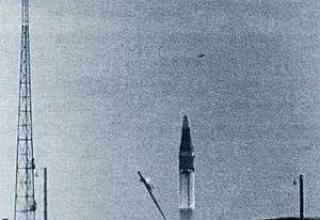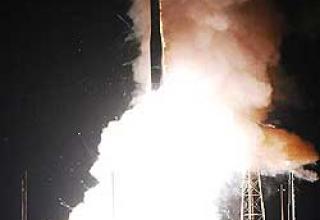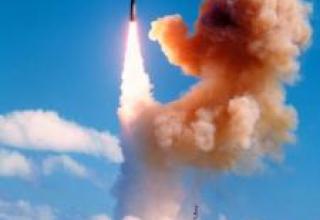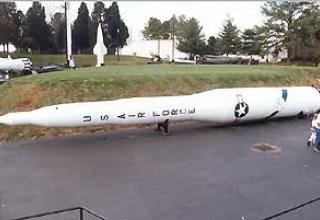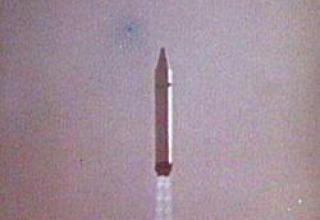In 1972 a special governmental commission was engaged in research of prospects of development of strategic nuclear forces of the USA till the end of 20th century. As a result of its work, the administration of President Nixon gave the task to develop a promising ICBM capable of carrying a dividing head unit with ten combat units. Research work on the development program of a new ICBM began in February 1972, and in April the U.S. Air Force Headquarters gave the new missile a provisional designation MX (Missile eXperimental) and appointed the SAMSO ("Space and Missile Systems Organization") to be responsible for the program. The new missile was to outperform its predecessor ("Minuteman-III") in terms of accuracy, number of combat units (BUs), their effectiveness, area of BW propagation area, resistance to PFCs, and so on. The new missile was designed primarily to destroy highly protected targets - missile silos and protected command bunkers in a preemptive strike. Its high accuracy and payload made it truly effective; the missile's survivability was supposed to be improved by mobile deployment. Aeronautical, ground, rail and other options were considered as mobile basing options (up to 40 different basing options, including the most exotic ones, were considered at different times). For example, in October 1974, an experimental launch of the Minuteman-IB ICBM dropped from the C-5A Galaxy military transport aircraft was conducted. The first stage of the ICBM contained a fuel charge for a seven-second flight. The experiment confirmed the potential for a mobile aviation-based option.
At the beginning of 1976, the MX program moved from conceptual design to prototype production. In July of the same year, the U.S. Congress blocked the allocation of funding for the development of stationary mine and aircraft types of base and proposed to consider other options for placement of the new ICBM. Alternatively, the option of placing the MX ICBM on a platform moving in a specially prepared secure trench and the option of placing the MPS ("Mobile Protective Shelters") system of mobile protected shelters were proposed. According to the MPS concept, 4,600 shelter launch sites were to be established to accommodate 200 ICBMs for horizontal deployment of missiles scattered around a large diameter circumference. The missile was to move covertly from shelter to shelter under random law. The level of shelter protection was to be such that only one shelter could be disabled by one enemy attacking warhead. When the launch signal was received, the shelter's roof moved apart and the missile was launched in an upright position using a system of special jacks. In April-May 1978, Martin Marietta Corporation was selected as the main contractor for the development of the MX ICBM, while Thiokol, Aerojet, Hercules and Rocketdyne corporations were awarded contracts for the development of the 1st, 2nd, 3rd stage and dilution stages, respectively. The combat units were developed by AVCO, the combat unit - by Lawrence Livermore National Laboratory, and the full-scale integration of combat equipment was also conducted by AVCO. The inertial control system was developed by Rockwell Autonetics, while the BCVM was developed by Hewlett-Packard. In June 1979, full-scale engineering development of the MX missile with the main type of basing according to the MPS concept began. However, in the course of work it became clear that the chosen type of base required not only large financial expenditures ($ 37 billion), but also a huge amount of alienated land. In October 1981, by decision of President Reagan, the work in this area was curtailed.
Despite this, the missile systems continued to be tested - by the end of 1981, all three marching stages and a dilution stage had been tested on ground stands, and the combat units, the ABM SLCBs and components of the inertial control system had been tested in flights on Minuteman-III ICBMs. In 1973-1986, 14 nuclear explosions were carried out at the testing ground in the state of Nevada under the program of testing of combat units and missile systems for resistance to PFN. In January 1982, for the first time a research "mortar" launch of a missile mock-up was carried out at a special stand at Nevada Test Site.
In November 1982, the missile under development received a new designation - LGM-118A "Peacekeeper". At the same time, work was launched on a new version of the base, the so-called "tight packing" - CSB ("Closely Spaced Basing", aka "Dense Pack"). According to this concept, the construction of super reinforced shafts (designed for overpressure at the shock front of more than 700 kgf/cm2) was supposed to be just 550 metres apart. The idea was to mutually destroy enemy attack warheads and dampen the shock waves of nuclear explosions, which would allow the main part of the SLC to survive and launch it back. However, it quickly became clear that the CSB concept was based on extremely questionable assumptions.
To address the issue of LGM-118A ICBM deployment, a special government commission headed by General Skoucroft was established. The verdict of the commission was released in April 1983, which stated that due to the deactivation of heavy Titan-II ICBMs it was urgently necessary "to demonstrate national will" to deploy 100 LGM-118A "Peacekeeper" ICBMs in the existing mines of missiles "Minuteman-III", as well as to begin the development of light monoblock solid-fuel mobile ICBMs (later called "Midgetman"). This solution allowed for rapid deployment of new ICBMs at relatively low financial costs and was approved by the Reagan Administration. The 400th and 319th Strategic Missile Squadrons of the 90th Strategic Missile Wing, located at F.E. Warren Airbase (Wyoming), were chosen to deploy missiles. This deployment option did not allow the LGM-118A ICBMs with a normal load (10 BB + ABI SLCM) to engage southern Soviet heavy missile groups. In August 1983, the U.S. Secretary of Defense authorized the beginning of work on the deployment of missiles in the 90th strategic missile wing. The first missiles were to begin arriving at the unit in January 1986 and reach the alert status in December of the same year. The readiness of the entire group was to be achieved by December 1989.
It was decided to test the LGM-118A ICBM in two stages, with six launches each. The tests were conducted at the Western Test Site (Vandenberg Air Force Base, California). The first test stage of six launches was carried out in 1983-1984. The launches were carried out from the launch container installed on a special site. In February 1984, began mass production of missiles. The second stage of testing began in 1985 and ended in 1986. The first two launches of the second stage were also conducted from ground PC, the next - from the converted shafts of ICBM "Minuteman-III".
In July 1985, the program was waiting for a new test - the Congress limited the deployment of missiles to 50 copies. Another 50 were to be deployed after the new basing plan, which would ensure increased survivability, was implemented. Thus, it was decided that the missiles in the first phase would be deployed on the basis of only the 400th Strategic Missile Squadron. The first Minuteman-III missiles began to be removed from mines in January 1986. SAC Air Force received the first four missiles for deployment in October 1986.
In December the same year, U.S. President Reagan announced a plan to deploy the remaining 50 missiles. The plan was called "Peacekeeper Rail Garrison" and involved the deployment of 25 railway complexes, each of which was to accommodate 2 missiles LGM-118A.
In December 1986, the U.S. Air Force SAC announced that the first link of 10 LGM-118A missiles had reached the initial operational status. However, the flight tests recorded unsatisfactory performance of the gyrostabilized platform of the missile inertial control system. It was decided to conduct the third stage of testing (also of six launches). The launches were combined with batch tests and started in 1986. Technical problems with the control system were eliminated, but the Electronics Division of Northrop Corporation (which took over Rockwell Autonetics) did not have time to supply an extremely complex system (about 20,000 parts only in a gyrostabilized platform) in sufficient quantities. As a result, by July 1987, up to one third of the 20 missiles in the mines did not have an installed control system. By January 1988 the problems had been solved and all the missiles received the control system; 30 missiles were already on combat duty.
In February 1987, the Air Force published a list of ten air bases - candidates for the deployment of the system "Peacekeeper Rail Garrison". 350 million dollars were allocated by Congress for the preliminary development of the project. 3 tests were conducted from January to June 1988 with the conclusion of the experimental train to various parts of the U.S. railways. In May 1988, the U.S. Department of Defense authorized the full deployment of this program. In 1987, after five successful launches under the third test program, it was decided to temporarily "slow down" it - for the Air Force was on account of each missile released. In March 1989, the last test launch was carried out and it was announced that the system had reached full operational readiness. In April of the same year, the new President J. Bush senior announced that the number of simultaneously deployed missiles would not exceed 50 - already deployed missiles would be removed from mines and placed on trains. This was a tribute not only to the "warming between East and West", but also to the appearance in service of the USSR's Strategic Missile Forces of the newest missiles - R-36M2 Voevoda, RT-23 UTTH Molodets and RT-2PM Topol - capable of engaging the Peacekeeper ICBMs and ICBMs. In September of the same year, the Air Force SAC began training and operational launches of the new missile, and in November, the Air Force announced air bases selected to house the missile trains - Barksdale, Louisiana, Little Rock, Arkansas, Grand Forks, North Dakota, Dyess, Texas, Wurtsmys, Michigan and Fairchild, Washington. The F.E. Warren base was to become the main technical base for the programme. The first train was supposed to be on combat duty in December 1992. During the development of the combat railway complex (BZHRK) Americans faced a number of technical and organizational problems, but then suddenly they were helped by the Soviet leadership by agreeing to sign in July 1991 the treaty on the reduction of offensive arms START-1, according to which significantly reduced the number of Soviet heavy ICBMs, and already deployed Soviet BZHRKs stopped combat duty on the highways of the country, standing on static duty in the bases. After that, the work on the promising strategic missile systems of the U.S. ("Peacekeeper Rail Garrison" and "Midgetman") sharply slowed down, and in January 1992 both programs were finally closed.
With regard to the development of the American FDLR, the following should be further noted. According to foreign sources, the BZHRK prototype was tested at the U.S. railway range and the Western Missile Range (Vandenberg Air Base, California) until July 1991. The possible appearance of the American BZHRK included: one or two standard locomotives, two launch cars with MX missiles, a car (command post) with combat control and communications equipment, a car of power supply system, two cars for personnel and support cars. The mass dimensions of the missile made it possible to develop a launch wagon adapted to the US railroad network. It was almost 30 m long and weighed about 180 tons. The container with the rocket was lifted to the launch position by a special lifting mechanism. In order to reduce the load on the rails the launch wagon had eight wheel sets. Shock and vibration loads were reduced due to air and spring shock absorbers. In a separate section the checking and starting equipment was placed. There was also equipment of different technical systems in the combat control and communication car. The locomotives were operated by civilian train brigades. In peacetime conditions, ELBCs were to be on combat duty at permanent bases, at "one of several thousand" pre-selected sites or to conduct combat patrols. With the transfer of the U.S. Strategic Offensive Force from peacetime to wartime, it was planned to rapidly dispense complexes over a large area. After receiving orders to launch missiles, BLWCs would proceed to the nearest parking lot, where ICBMs were being prepared for pre-launch and launched. According to the results of the tests, the U.S. military leadership planned to put on combat duty up to 25 ERBMs with two "MX" missiles in each. Seven air bases located in different states were considered as permanent deployment points for the complexes. Approximately 110,000 km of the United States railway network could be used for the dispersal of BZHRKs.
In early 1991, the U.S. military and political leadership unexpectedly announced that the comprehensive tests of the BZHRK had been successfully completed. At the same time, however, a set of problems was listed. In particular, it was noted that the relative underdevelopment of the US railway network did not ensure high secrecy and survivability of BZHRK. Attention was drawn to their vulnerability and insufficient physical protection against ground and air attacks by a likely enemy, sabotage and terrorist groups. Significant costs were required to strengthen railway tracks and construct various infrastructure facilities. The negative attitude of the population towards the movement of nuclear missile weapons through the states and the potential threats of environmental damage was revealed. In the interest of strengthening the secrecy regime, it was deemed impossible to use civilian specialists. Nevertheless, in the course of the negotiations, the Americans apparently convinced the Soviet side that a significant scientific and technical backbone had been created for the deployment of ELWs. However, the analysis of information materials of those years makes it possible to conclude that the production of even a prototype of the American FLIR and its full-scale tests were far from being completed. Thus, the only missile test launch from a railway launcher failed for technical reasons and was replaced by a drop test. Therefore, it is not possible to see a solution to the problem of diverting the jet stream from the launch wagon during the launch of the missile's marching engine after its release from the container. It was noted that the MX rocket was designed for a silo-based version, had not been modified and did not have the rocket's climbing engines after launch. This could result in a fire and the failure of the launch wagon and the railway track section. The determination of the composition, appearance and requirements for the facilities of the permanent basing points of the BZHRK and the railway infrastructure was stopped at the stage of conceptual design. There were no options for dispersal and combat patrolling with the use of an experienced BZHRK on the real railway network. It was not possible to develop highly accurate systems for the navigation of FLLCs and for the targeting of missiles when preparing launches from any suitable railway sections. There were no complex resource and transport tests of the BZHRK with the "MX" rocket with the withdrawal to the railways and the development of combat training tasks. The missile's behaviour under real shock and vibration conditions was not assessed. The problem of creating a centralized system to control the combat patrol of the LRBMs on the US railways, which were in the hands of private companies, was not solved. The combat railroad missile system had a significant number of disguising features. It was impossible to practically develop the forms and methods of combat use of FLIRVs, the ideology of their dispersion, the organization of combat duty and control of nuclear missile weapons on combat patrol routes, and the basics of their technical operation and comprehensive maintenance.
Not surprisingly, the main efforts of Washington were aimed at restricting the functioning and subsequent elimination of domestic FLWRs. To this end, the Americans achieved the inclusion in the texts of the START Treaty and its annexes of unilateral restrictive and liquidating articles and procedures, the implementation of which led to the destruction of our railway missile systems, although the Pentagon did not plan to deploy its own similar grouping. This is confirmed by the following. Thus, in accordance with article III, paragraph 10 (b), of the Treaty, the United States side declared the existing types of ICBMs for mobile launchers to be "MX" missiles (no TTHs were specified for the railway version of the missile), noting that the mobile version of the missile was not deployed. In accordance with Section II, paragraph 2. (b) and annex A of the "Memorandum of Understanding to establish baseline data in connection with the Treaty between the USSR and the United States of America on the Reduction and Limitation of Strategic Offensive Arms", the Americans submitted: Number of missiles and payloads of ELISAs - 0; their deployable weight - 0; non-deployed mobile launchers - only prototype; test launcher - 1; fixed structure for mobile launchers - none; transport and loading facilities - 1; non-deployed MX missile at the range - 1. Photos of the launch wagon and other means according to Annex J (by mutual exchange) were not presented. Thus, in reality, the American BZHRK existed mainly in the form of loud statements by US politicians. Neither were the objects of infrastructure of the assumed permanent deployment sites declared. During the inspections it turned out that the Americans did not think to start retrofitting the above-mentioned air bases in order to deploy their BLW. Obviously, they did not want to invest in waiting for the START Treaty to be signed.
After it became clear that the deployment of LGM-118A ICBM missiles would remain silo-based, it was decided to take measures for deep upgrading of electronic equipment and communication systems of command posts ("Rapid Execution And Combat Targeting" program - "accelerated execution of combat control and redirecting commands"). However, after the signing of the new START-2 treaty in January 1993, according to which "Peacekeeper" missiles were planned to be on duty as MIRV missiles by the end of 2004, these plans were redirected to the Minuteman-III ICBM (modernization was carried out from October 1994 to August 1996). By that time, the structure of the U.S. Air Force had changed - the SAC was disbanded in 1992, and all the ICBMs were transferred to the formed Space Command of the Air Force, all strategic missile wings were renamed into space wings, and strategic missile squadrons were renamed into missile squadrons with the number preserved. In addition, there was a reduction in the number of air bases with ICBMs - from 9 in 1982 to 3 in 1998. In June 2001, U.S. Defense Secretary D. Rumsfeld announced the withdrawal of LGM-118A ICBMs from service. Despite the fact that Russia considered itself not bound by the treaty on the reduction of ICBMs with RGCH IN due to the withdrawal of the U.S. from the ABM Treaty of 1972, the dismantling of LGM-118A missiles began in October 2002 with the rate of 1 missile in 17 days. The dismantled missiles were sent to Hill Air Base, Utah, for storage. By January 2003 on duty 46 missiles of 50, by January 2004 - 29. In the same year, a training and combat launch of this ICBM was held, which was the last. A total of 51 ICBMs were launched between 1983 and 2004 (18 of them under the test program), only one launch was completely unsuccessful, in 2001. The combat training launch, scheduled for August 2005, was cancelled. In total, 114 missiles were built. By January 2005, only 10 ICBMs remained on combat duty and the last one was removed from combat duty in September 2005, and the 400th rocket squadron of the 90th space wing was deactivated in October of the same year. Based on the elements of the removed from combat duty ICBM "Peacekeeper" and "Minuteman-II" developed conversion radars of the family "Minotaur" - "Minotaur-IV" and "Minotaur-II" respectively.
Looking at the Peacekeeper missile system as a whole, American engineers have managed to create a truly highly advanced new-generation ICBM, which, thanks to much higher accuracy of fire, has been able to destroy the most fortified strategic targets in the USSR. U.S. experts assessed the probability of destroying the 15A18 ICBM system by two hits of the Mk21 BB with the W87-0 BC (Peacekeeper ICBM) of 300 kt each as 0.962, while two Mk12As with 335 kt each destroyed the same mine with a probability of only 0.59 and two Mk12s with W62 (Minuteman-III) with 170 kt each destroyed the same mine with a probability of only 0.407. The missile had a fairly strong BMD ICBM, and the missile and its combat equipment had significantly increased resistance, compared to its predecessors, not only to NNFVs, but also to weapons based on new physical principles. The upgraded shafts provided the complex with increased resistance to foammable substances (first of all, to excess pressure in the shock front - up to 155 kgf/cm2 and to seismodynamic soil displacement). According to the calculations of American experts, the LGM-118A missile was 6-8 times more effective than the Minuteman-III missile. The development of this missile in the U.S. forced the USSR to start developing its analogue of this missile - RT-23 UTTH ICBM, which was put on duty in two versions - mobile railway and stationary mine, and was not inferior to the Peacekeeper ICBM in terms of combat efficiency. Nevertheless, despite all the advantages, the MX program as a whole can be assessed as having failed to accomplish a significant number of its tasks (although, in part, the Americans were able to "spin" the USSR at a huge cost associated with programs to build and deploy several new or upgraded types of ICBMs of different bases at once). Therefore, with the approaching expiration of the 20-year warranty period, the U.S. has abandoned further use of this ICBM (although, taking into account the experience gained with the Minuteman ICBM in extending its solid fuel warranty period and having a stock of missiles produced, the U.S. could have operated this missile in its arsenal for at least another 10 years). The choice was made to significantly enhance the capabilities of the Minuteman-III ICBM, including through technologies developed under the MX program.
Composition:
The LGM-118A "Peacekeeper" ICBM (see schematic) is a solid-propellant three-stage missile whose stages are connected in a longitudinal pattern. All three marching stages were made of Kevlar 92'' type Kevlar epoxy material and had a black multifunctional coating on the outer surface that protected the missile from the effects of PSNF and aerodynamic heating. Each stage had one central, partially recessed into the combustion chamber, and a deflected nozzle, which allowed the missile to be guided through the channels of pitch and yaw. The nozzles were made of special Kevlaro-epoxy material, the material of the necks was high-purity pyrographite. Nozzles of the second and third marching steps were equipped with a retractable conical nozzle on the nozzle body. To extend the nozzle a special pneumatic-hydraulic drive was used. This solution allowed to provide the required degree of nozzle expansion (and, accordingly, the maximum engine thrust) while reducing the size of the rocket. To control the missile on a roll channel in the second stage operation area, two gas generator stand-alone blocks were used, attached to the stage nozzle block. In the first and third stages of operation there was no control through the roll channel, and the accumulated error was compensated during the second stage and the breeding stage. At the first and second stages solid fuel HTPB Class 1.3 was used, at the third stage solid fuel NEPE Class 1.1 (unified with fuel of Trident-2 D5 submarine). Stage separation was performed by injection of interstage space with the help of a special gas generator and subsequent longitudinal division of the stage connection with the help of extended conical charge. The breeding stage was separated from the third marching stage after pyrobolt triggering and opening of counter-retraction nozzles at the third stage, which silenced the RDTT stage and led it away from the breeding stage.
The breeding stage (see photo) was made of special aluminum alloys. On the outside, the breeding stage had a multifunctional black coating that protected against the effects of PSFA and aerodynamic heating. The breeding stage was equipped with a marching LCD with a fixed central nozzle and eight small steering engines, which allowed the stage to be controlled by pitch, yaw and roll. Fuel of a breeding step of LRD is nitrogen tetraoxide as an oxidizer and monomethylhydrazine as a fuel. The fuel tanks of the stage were inflated with helium placed in a special tank. The stage was carried by a splitting head unit (RSHH IN) (see photo), which consisted of 10 combat units (BB) Mk21 of individual guidance, equipped with a BC W87-0 with a capacity of 300cts and implemented the so-called "pushing" dilution algorithm. The breeding area of the combat equipment was up to 320000 sq. km. The maximum configuration option provided for equipping of LGM-118A ICBMs with eleven Mk21 BCs. An option to equip the missile with Mk12A combat units with a 335-kt BC W78 from the Minuteman-III missile was also considered. In this case ICBM could carry up to 12 such blocks, but the choice was made in favor of a heavier and less powerful, but more accurate, PFC-resistant, low-profile and low-cost Mk21. The combat equipment was covered by a triconical titanium head fairing fired from above at the end of stage 2. The breeding stage had special compartments to accommodate the elements of KSP PRO (light inflatable and heavy false targets, dipole reflectors, active interference generators, infrared aerosols). The mass of the KSP PRO reached 500 kg. According to a number of data, after the completion of the formation of combat orders from the ballistic missiles and decoys, the stage was undermined, forming an additional field of decoys.
The NS-50A inertial control system with AIRS ("Advanced Inertial Reference Sphere") gyrostabilized platform and LC5400 type "Meca" on-board digital computer system is located in the propulsion unit compartment of the dilution stage. The BCVC provides flight control in the active part of the trajectory, at the stage of combat unit deployment, as well as in the process of combat duty and preparation for launch. The high quality of NS-50A IMS devices, recording of errors and application of new algorithms ensured high firing accuracy. The drift of NS-50A IMS is less than 1.5x10-5 degrees per hour. The control system is cooled with freon in flight to create the required temperature mode of operation. The rocket's electronics are made on radiation-resistant semiconductor electronics of RAM-type. The control system provided the missile with very high accuracy (KBO ~ 90 m).
To ensure the launch of the LGM-118A rocket, the American designers, for the first time, used the so-called "mortar" scheme. LGM-118A ICBM launch complexes (see the scheme) were modified LGM-30G "Minuteman-3" ICBMs, from which all equipment associated with the gas-dynamic scheme of LGM-30 missile launch was removed and a special launch container made of graphite fiberglass reinforced plastic was installed. Solid fuel gas generator located in the lower part of the container, when triggered, ejected the missile to a height of 30 m from the level of the mine protection device, after which the first stage marching engine was activated. The rocket was locked in the launch container by means of nine rows of special polyurethane tiles (see photo) covered with teflon-like material. They performed cushioning and buffering functions and were automatically removed after the rocket left the mine. Because the missile mounted in the launch container partially protruded from the launch container and was smaller in diameter, to prevent foreign objects from entering the launch container, the clearance between the upper trim of the launch container and the ICBM casing was protected by a lightweight polyurethane tile hood, which was removed during launch by the movement of the ICBM casing. ICBMs were installed in the ICBM launch container in a sequential manner using modified Minuteman ICBMs (in this regard, Soviet systems based on a single transport and launch container were significantly ahead of the LGM-118A).
The command post of the complex practically did not differ from the Minuteman ICBM and was a cylinder-like structure made of heavy reinforced concrete with hemispherical tips, reinforced from the inside by a layer of special steel. Inside this structure was located the actual command post, cushioned by a special suspension. The entrance to the control room was closed by a steel door weighing 9 tons, which could only be opened from the inside. The control itself was underground at a depth of about 12 meters and could protect, according to American experts from "very close explosion of nuclear ammunition with a capacity of 15 kt". In the second half of the 70s, after the USSR had ICBMs and SLBMs with accurate and powerful UAVs, work was done to increase the resistance of the OS KP and SLBMs to the electromagnetic pulse of nuclear weapons and the flows of formed elementary particles.
A crew of 2 officers was on duty for 24 hours inside the control room. The officers were armed. The whole complex was guarded by a special police unit of the Air Force, located in a one-storey service building above the control station. The control room and all OS FPUs were equipped with security alarm systems. Inside the command post there was one sleeping area, a storage and cooking complex, a sink and a toilet. KP officers watched their 10-rocket link and could control any of the other four links of the squadron if necessary. To launch missiles from the entire squadron (50 ICBMs), two control calculations (or, in an extreme situation, one control calculation and the EC-135 "Looking Glass" air command post calculation) were required. The ICBM was launched after a special order was received and verified by both officers. To launch the ICBM, a special code word was entered into the verification and locking equipment, each officer inserted his key into a special well, after which the officers simultaneously (within 2 seconds) turned the keys by 1/4 turn and held them in this state for 5 seconds. ICBMs were launched within 30 seconds after the missile control system received the launch order.
Characteristics:
| General characteristics | |
| Maximum firing range, km | 9600 |
| Circular probable deviation, m. | 90 |
| The diameter of the rocket, m | 2,34 |
| The length of the rocket is complete, m | 21,61 |
| The mass of the projectile, t. | 88,443 |
| The mass of an unarmed missile, t. | 10,885 |
| Start container length, m | 20,79 |
| Diameter of the starting container, inner, m | 2,5 |
| Stage I | |
| Length, m | 8,534 |
| Weight, t: - climbing ladder - empty stage |
48,985 3,628 |
| RDTT traction at sea level, tc. | 226,8 |
| Specific impulse of RDTT at sea level, s | 282 |
| RDTT operating time, s | 56,5 |
| Stage II | |
| Length, m | 5,486 |
| Weight, t: - climbing ladder - empty stage |
27,667 3,175 |
| RDTT traction in vacuum, shh. | 124,7 |
| Specific pulse of RDTT in vacuum, s | 309 |
| RDTT time, s | 60,7 |
| III stage | |
| Length, m | 2,438 |
| Weight, t: - climbing ladder - empty stage |
7,710 0,635 |
| RDTT traction in vacuum, shh. | 29,5 |
| Specific pulse of RDTT in vacuum, s | 300 |
| RDTT time, s | 72 |
| Breeding level | |
| Length, m | 1,22 |
| Weight, t: - Knitted breeding stage (without KSP PRO, BB/HF and head fairing) - of an empty dilution stage (without CSP PRO, BC/HF and head fairing) - combat equipment (CB/HF) - SCC ABM |
1,179 0,544 2,131 0,5 |
| Number of steering engines | 8 |
| Pulling, shh. - vacuum marshal RDTT - vacuum steering |
1,16 0,032 |
| Specific pulse, s - vacuum marshal RDTT - vacuum steering |
308 255 |
| Steering engine running time | 168 |
| Number of combat units, pcs. | 10 |
| Battle unit power, kt | 300 |
| Apogee trajectory BB, km | 1 000 |
| Speed (approx. 30 m above sea level), mph. | 15000 |
Testing:
Tests of "Moskit" complex started in June 1978 at "Sandy Beam" range. The flight and design tests began with two throw launches on June 9 and October 10, 1978. The mock-up of the rocket was equipped only with the starting engine. Both launches were normal. Then came a long break, mainly due to the unpreparedness of the material part of the rocket, in particular, the marching engine, which was difficult to be brought to the manufacturer.
On December 29, 1979 a model equipped with a marching engine was launched. The launch was unsuccessful, as the marching engine was not launched, and the starter remained in the nozzle block of the marching engine after development. After the start, a timeout was taken again to rework the marshal engine. The next launch took place only on July 3, 1980. The task of the launch was to get a reliable start of the rocket and make a flight at an altitude of about 20m. The launch was considered to be successful, but the marching engine never reached the design mode.
January 27, 1981 the rocket "Moskit" for the first time was launched in full configuration, but without turning on the active channel combined CNS. The rocket was to hit the target SM Pr.1784 at a distance of 38 km. The launch was unsuccessful due to instability of the onboard control system. At launch on April 28, 1981 a task similar to the previous launch was set. Direct hit to the target was achieved. On June 2 there was shooting at two targets - SM pr. On June 2 there was firing at two targets - SM Pr. 1784 and BKShP No. 436 bis at the distance of 38 km without switching on the active channel of combined GSN. The launch was successful and a direct hit to a larger target, SM, 1784 Pr. was achieved.
By the beginning of June 1981 a new modernized target SM Pr.1784 arrived to provide flight tests of ZM-80 missiles. 1784M Prospect, manufactured in Nikolaev. On this target, as well as on the old SM Ave. The whole system of radar reflectors in the amount of about 50 pieces of different types (K-0.7, K-1.25, etc.) and a thermal imitator "Balancer" working on household gas propane-butane were left on this target, only instead of one burner there were two (it was believed that a big ship - a battleship, a cruiser or an aircraft carrier - had at least two radiation centers). The target of the CM Ave. At the SM target of 1784M Ave. the system of external trajectory measurements was fundamentally improved. Previously, the film camera and photo equipment, shooting the missile approach to the target, were installed "on the eye", and now the film camera was tied to the target itself with a high degree of accuracy. The camera viewing angles were chosen so that they necessarily included some element of the target structure in addition to the missile. In order to test the operation of the active channel of the combined RS on a ZM-80 missile on the SM target, the cameras were designed to be able to detect the target. 1784M was equipped with a special system called "Minaret". The system included "Don" radar with a modified antenna system, remote control system for television signaling and telecommunications, equipment for documentation of operating modes, etc. In addition, two "Puck" and "Rynda" systems were installed, which determined the missile miss rate. The "Puck" system determined the magnitude of the miss relative to its antenna, and the "Rynda" system determined the magnitude of the miss relative to the so-called "reduced target". The target also had a well-equipped cockpit to accommodate the team. On June 26, 1981, two targets were fired - SM Pr.1784M, set from the starting point at a distance of 40 km, and on the BKShchina Pr.436 bis, set from the starting point at a distance of 10 km. The missiles were launched with active and passive CNS channels connected. The launch was considered successful. The missile hit the SM target at 436bis Ave. 1784M (pierced the target grid at 1.0m from the deck) and was driven 80km from the launch point. This launch ended the program of flight and design testing of the Moskit complex.
Launches under the program of joint (state) testing began in August 1981. At this stage of testing, the missiles were launched both from the coastal launcher and from a large missile boat of project 1241.1 (plant № 402) and destroyers of project 956 "Modern" (plant № 861) and "Desperate" (plant № 862). The first launch under the joint testing program took place on August 21 from the coastal launcher on target SM of 1784M pr.1784M to the range of 102 km. The task of the launch was to check the operation of all units and assemblies. Direct hit to the target was achieved. On September 30 it was launched from the boat of project 1241.1. The model of the rocket was equipped only with a starting engine. The mock-up was launched normally from the boat, which ran at a speed of 24 knots. when the sea waves 2-3 points. After that, the boat with the factory number. 402 was allowed to participate in joint testing of the Moskit complex.
On October 2, 1981 the launch was made with the task similar to the launch on August 21, but this time the target was not exposed. The launch was considered successful.
On November 24th the boat of project 1241.1 was launched from the target of SM Pr. On November 24th it was launched from the boat of the project 1241.1 on the SM target of 1784M pr. for the range of 100 km. The launch ended in failure due to a malfunction in the onboard control system. The rocket fell into the sea on the 10th second after the launch.
On December 27, 205 and 305 missiles were fired in volley from the boat of 1241.1 Ave. at two targets - BKShchinskaya Ave. 436 bis and SM pr. 1784М. The distance to the target of the BKSh was 10 km. Missile No 205 was aimed at this target. The launch was considered successful - a direct hit to the target was achieved. The range to the SM target was 33km. Missile No. 305 was to be aimed at this target. The launch was unsuccessful - the covers of the air intakes of the marching engine did not open, and the missile was brought to 23.7 seconds of flight. The interval between launches was 5 seconds.
On April 14, 1982 the missile was launched from the shore-based installation on the target of the SM Ave. 1784M Ave. at a distance of 100 km. The launch was unsuccessful. The missile fell at the 24th km distance due to malfunctions in the onboard control system.
On April 29, the first launch from the destroyer of the project 956 "Modern" in the Northern Fleet on the target of OS-111 (trawler project 265K) at a distance of 141 km was made. The launch was successful - a direct hit to the target superstructure was achieved. May 26, 1982 volley firing of rockets № 106 and № 505 from the destroyer "Modern" on the target of OS-111 at a distance of 35.5 4 m was carried out. Both missiles with equipment for the combat unit TC-22 were simultaneously launched from both sides of the destroyer. Rocket number 505 hit the target, hitting its superstructure. Rocket number 106 did not lower the flight height in front of the target, flew over it at an altitude of 17 m from the waterline and flew 47.5 km. The shooting was found to be partially successful. But the rocket number 106 could have flown not 17 m above the waterline, but 170 m, still with the presence of TC-22 ship would not have seemed a little Yankee.
On August 31, 1982, it was launched from the boat of project 1241.1 at a distance of 100 km with a 50-target position after the launch from two targets of OS-111 and SM pr. 1784М. The launch was unsuccessful - the marching engine was not launched and the missile fell into the sea at a distance of 12.8 km from the boat.
September 15 was a repeat of the previous launch. On September 15, it was a repeat of the previous launch. 1784M Ave. and hit it. The actual range of fire was 107.7 km.
On September 29 the boat of project 1241.1 was launched from the boat to the range of 27 km at the target of OS-1.11. A direct hit was achieved, the target sank.
November 28, volley firing of rockets ¹ 306 and ¹ 506 was made from the destroyer of project 956 "Desperate" in the Barents Sea in the Northern Fleet. (Shots were fired in parallel with the ship's delivery tests.) The target range of the target was set at the SM Ave. 1784 was 27 km. The speed of the ship during the launch was 20 knots. Firing was carried out from the starboard launcher, the interval between launches was 5 seconds. The target was hit by both missiles.
This was the end of the joint testing of the Moskit complex. In the course of these tests conducted 15 launches (14 missiles and 1 mock missile). According to the decision of the State Testing Commission, there were 8 fully successful launches, 5 partially successful launches and 2 unsuccessful ones.
In the period from 1983 to 1988, there were three types of tests of the Moskit complex. Firstly, tests on improvement of tactical and technical characteristics, ZM-80 missiles were conducted. In total, there were three launches: March 11, 1983, June 29, 1983. (mock missile) and December 7, 1984. At this stage, the flight range of 125 km was achieved.
Since the early 1980s, the possibility of installing the Moskit complex on the Lunar screen of Project 963 was considered. For this purpose, a mock-up of the screen plan of project 903 was installed at the "Sandy Beam" range in the village of Chernomorsk. The main purpose of the tests was to check the ability of the screen plan design to withstand the force and heat of the starting engine jet. On October 5 and December 21, 1984 two launches of "Moskita" mock-ups equipped only with starting engines were held. The first launch was made from the right container of the bow pair of launchers, and the second launch - from the left container of the tail pair of launchers. Since there were only two containers, the nose pair stood in its place at the first start and then it was moved to the tail. During these tests were tested two options for loading missiles on the screen, the first version of the rocket was loaded into a container already installed on the screen, using the loading device, the second version of the rocket was loaded into a container located on the ground, and then the entire structure was installed on the screen. All launches went smoothly. After the first launch 9 tiles were damaged, after the second one - 2. There were two launches of ZM-80 missiles in the Caspian Sea. The target was the BKShchy Ave. 436bis. The first launch was unsuccessful due to crew errors. During the second launch there was a double salvo (at an interval of 5 seconds). The launch was counted as successful.
Sources:
- To defend and deter: the legacy of the United States Cold War missile program / J.C. Lonnquest and D.F. Winkler. USACERL, 1997.
- From Snark to Peacekeeper: a pictorial history of Strategic Air Command missiles / SAC HQ Office of the Historian, 1990.
- Alert operations and the Strategic Air Command, 1957-1991 / SAC HQ Office of the Historian, 1991.
- Strategic Air Command and the Alert program: a brief history / SAC HQ Office of the Historian, 1988.
- US Strategic and Defensive missile systems 1950-2004 / M.A. Berhow and C. Taylor. Osprey Publishing Ltd., 2005.
- History of the Mighty Ninety. Volume I / D.G. Sprong. 90th SMW Office of the Historian, 1990.
- Minuteman Weapon System. History and Description / ICBM Prime Team TRW Systems, 2001.
- www.strategic-air-command.com
- www.astronautix.com
- www.nuclearweaponarchive.org
- www.globalsecurity.org
- www.af.mil
- www.dodmedia.osd.mil
- www.fas.org
- www.arms.ru
